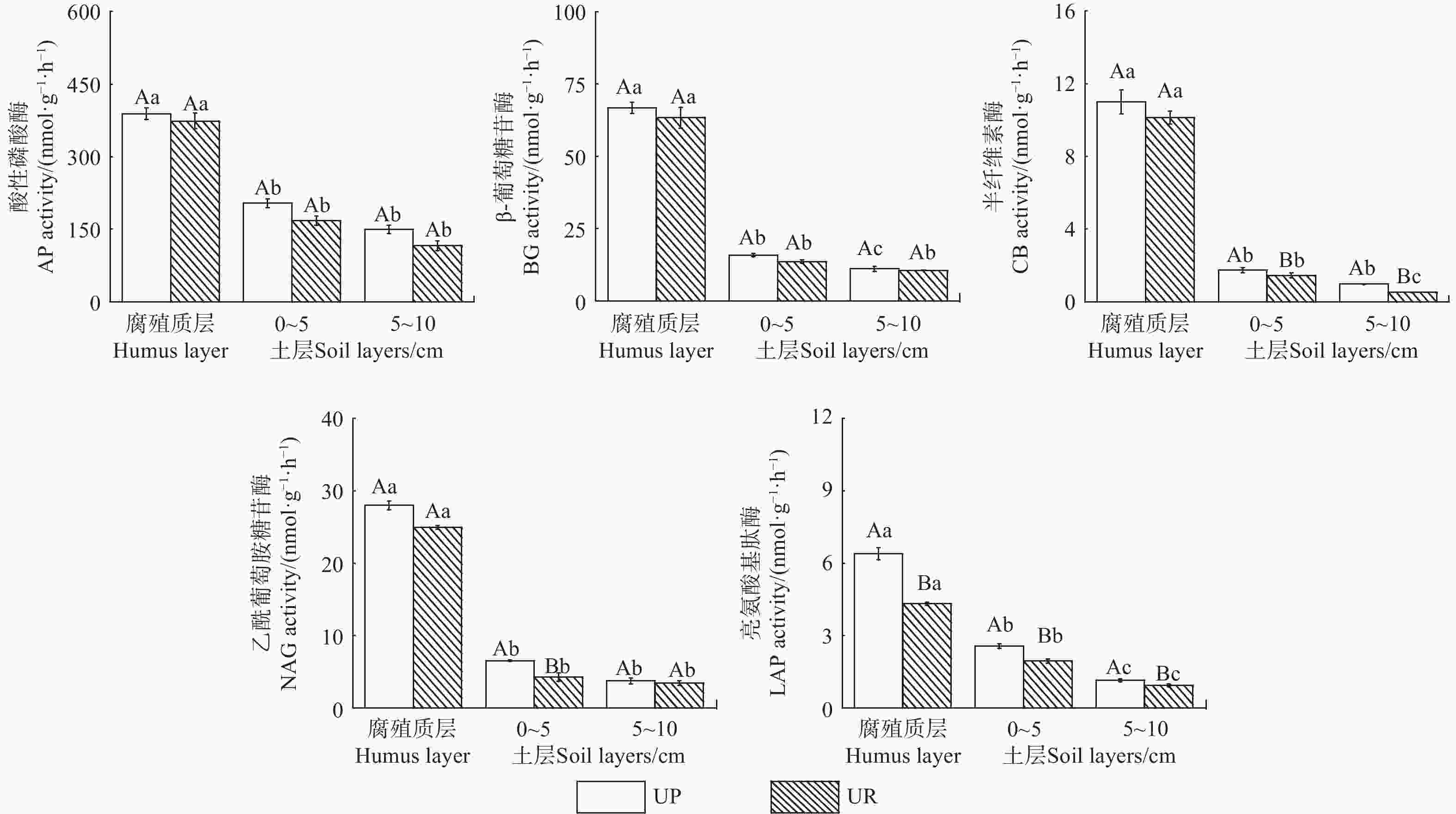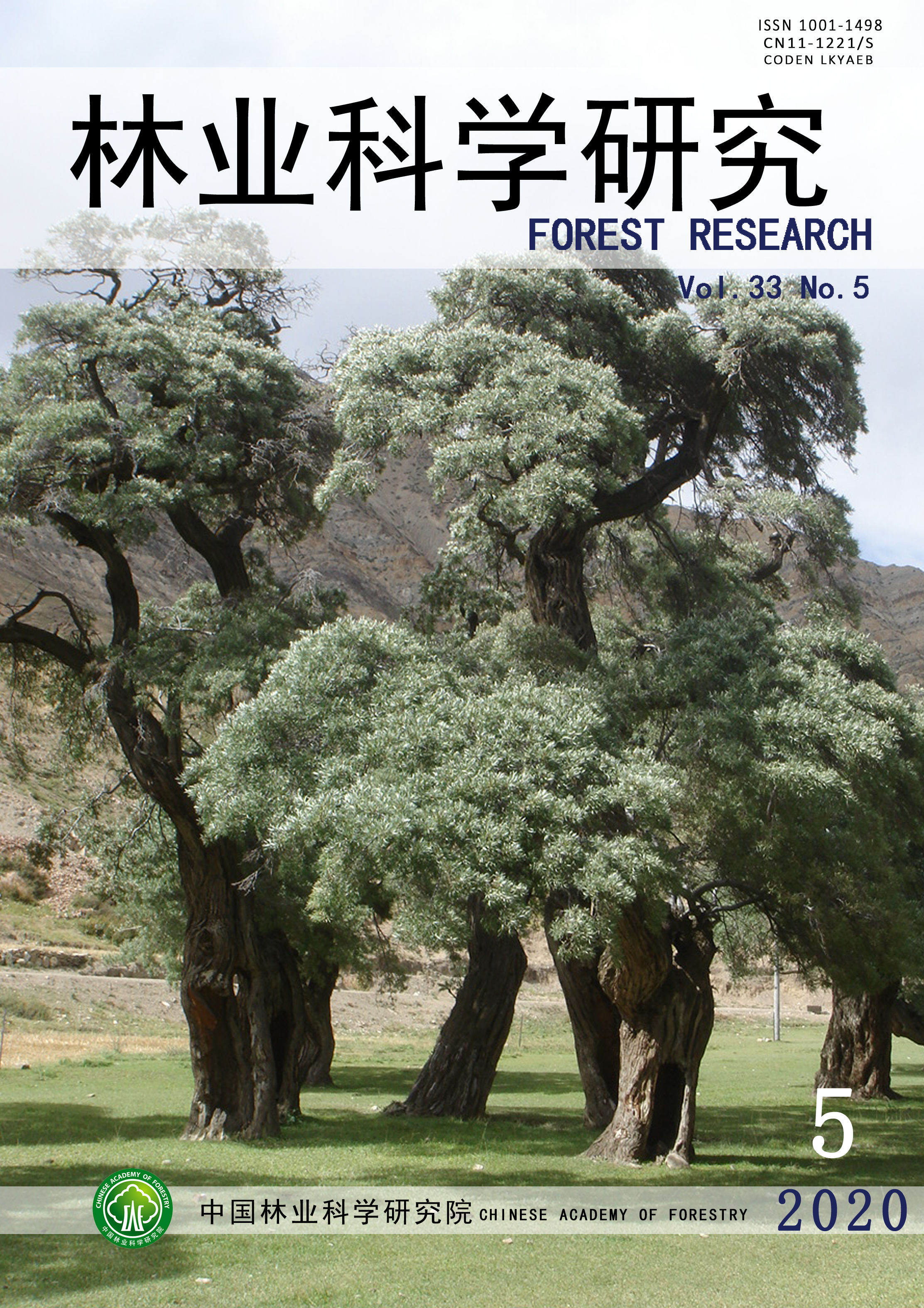-
林下植被可以增加人工林生态系统生物多样性和养分周转率,但其在维持森林生态系统结构和功能方面的作用通常被忽视[1],特别是在传统森林管理方式中,常采用林下植被去除的方式来减少树木和下层群落之间的空间资源竞争[2]。然而,林下植被可通过改变土壤生物化学过程,如微生物活性和组成、碳和其他营养物质的周转,进而影响森林生态系统长期的生产力和稳定性[3]。以往研究表明,林下植被完整时,土壤养分、微生物量、酶活性和土壤呼吸均高于林下植被移除[4-5]。因此,在人工林的经营管理中,林下植被的保留比去除可能更有利于森林土壤地力的提高,但目前林下植被管理对土壤生化过程的影响发生机制仍不清楚,需要开展更多的研究工作。
土壤酶是由植物根系或微生物产生,对土壤碳(C)、氮(N)和磷(P)等养分变化具有一定的灵敏性,其常被用作衡量土壤质量状况的关键指标[6]。土壤酶活性可以反映底物利用率、微生物和植物对养分的需求,同时也在一定程度上影响植物和微生物在土壤环境变化时维持其养分平衡的策略[7]。Xu等[8]通过研究我国东部南北样带沿线的9个森林生态系统中的土壤酶活性及其化学计量比,结果发现,土壤酶化学计量比能很好的反映微生物的营养需求和环境中营养物质的供应状况。因此,开展土壤酶化学计量的研究为理解土壤中养分的周转、循环和平衡过程提供了新途径[9]。目前,有关林下植被去除的相关研究主要集中于土壤酶活性,且研究结果存在较大差异。有研究表明,林下植被去除显著降低了土壤C含量和微生物生物量,同时也促使土壤水解酶活性降低[10];而Liu等[11]发现,去除林下植被对桉树人工林生态系统土壤酶活性无显著影响。因此,林下植被去除对人工林生态系统土壤酶活性的影响研究还需进一步探索,而且,从土壤酶化学计量的角度探究林下植被去除对土壤养分特征的相关研究相对较少,相关过程的研究可能对人工林养分维持及调控具有重要的指导意义。
杉木(Cunninghamia lanceolata (Lamb.) Hook.)广泛分布于我国南方,是主要经济树种之一,种植面积约占全国人工林面积的30%[12]。杉木能够高效吸收土壤养分进而决定了其速生特性[13],而林下植被去除可能会进一步改变杉木人工林中土壤水分和养分有效性,最终影响土壤酶活性[10],以往研究更多关注土壤酶活性变化,而从土壤酶化学计量比的角度探讨林下植被去除对土壤养分特征的影响研究较少。因此,本研究以养分较贫瘠的杉木人工林为研究对象,通过测定土壤C、N、P含量及5种C、N、P水解酶活性,计算养分-酶化学计量比,并进一步分析土壤理化性质与酶活性及其化学计量比的相关性,进而揭示亚热带杉木人工林林下植被去除和保留的土壤养分和酶活性的响应特征,为林下植被管理对土壤质量影响的评估提供参考。
HTML
-
试验样地位于江西省吉安市泰和县中国科学院千烟洲石溪林场(26°44'52″ N,115°04'13″ E),该区地处亚热带季风气候区,雨量充沛,四季分明,海拔102 m,年平均气温17.9℃,年平均无霜期280 d,年平均降水量1 489 mm。本研究试验样地杉木活立木平均树高13.6 m,平均胸径11.4 cm,林分密度1278株·hm−2,郁闭度76%。林下灌木层平均高1.3 m,盖度11%,林龄15 a,坡向为东南方向,坡度为15°;主要物种有毛冬青(Ilex pubescens Hook. et Arn.)、杨桐(Adinandra millettii (Hook. et Arn.) Benth. et Hook. f. ex Hance)、紫珠(Phyllostachys nigra (Lodd.) Munro)和黄栀子(Gardenia jasminoides Ellis)等;林下草本层茂密,平均高度0.8 m,盖度80%,优势种为铁芒萁(Dicranopteris pedata (Houttuyn) Nakaike)和狗脊(Woodwardia japonica (L. F.) Sm.),伴生有淡竹叶(Lophatherum gracile Brongn.)、菝葜(Smilax china L.)和土茯苓(Smilax glabra Roxb.)等。
-
2013年1月,在江西省吉安市泰和县石溪林场杉木人工林内设置8个15 m×15 m样方,将样方地面上的所有凋落物移除(单独研究林下植被的影响),采用配对试验设计方法进行2种处理:(1)林下植被保留(UP):保留样方中的林下植被;(2)林下植被去除(UR):在保留林下植被处理的样方附近划分与样方相同面积相近条件的杉木林,去除其中的林下植被。每个月对UP和UR样方内的凋落物进行人工徒手清除,以避免凋落物对处理结果的影响。
-
2018年7月,在每个样方内采用“S”型布点取样,共计9个布点,首先用三角铲收集50 cm×50 cm方格内矿质层以上的腐殖质层,然后再利用直径5 cm的土钻在该区域采集0~5、5~10 cm土层样品,将相同土层的样品混合后放入无菌自封袋内,做好标记,放入冰盒,迅速带回实验室。将土壤样品中的石砾、植物残根等杂物去除,研碎混匀,过2 mm筛,将土样分为2部分装入对应编号的无菌样品袋内,1份放至4℃冰箱内冷藏保存用于测定土壤酶活性和有效氮(铵态氮(NH4+-N)、硝态氮(NO3−-N));另1份土样风干测C、N、P养分含量。
-
土壤pH值(土水比1:2.5)用pH计测定;土壤含水量(SWC)用烘干法测定;有机碳(SOC)用高锰酸钾-硫酸亚铁滴定法测定;全氮(TN)和全磷(TP)采用HClO4-H2SO4消煮法,然后在连续流动分析仪上测定;铵态氮(NH4+-N)和硝态氮(NO3−-N)采用2 mol·L−1KCl作为浸提液(土液比1:10),在180转的振荡器上振荡2 h,静置过滤后采用连续流动分析仪测定[14]。
-
用荧光标记底物法[15]测定5种土壤酶(C水解酶:β-1,4-葡萄糖苷酶(BG)、半纤维素酶(CB);N水解酶:β-1,4-N-乙酰基-葡糖胺糖苷酶(NAG)、亮氨酸氨基肽酶(LAP)、P水解酶:酸性磷酸酶(AP))活性。
-
利用SPSS 19.0软件进行配对样本t检验,分析林下植被保留和去除处理对土壤酶活性、酶化学计量比以及土壤理化性质的差异,显著性水平为0.05;采用Pearson相关分析土壤酶活性及化学计量比与土壤理化性质之间的关系;利用Origin 2018作图。
2.1. 试验设计
2.2. 样品采集
2.3. 样品分析
2.3.1. 土壤理化性质
2.3.2. 土壤酶活性
2.4. 数据分析
-
表1表明:在不同土层中,UR处理的SWC、SOC、TN、TP、NH4+-N、NO3−-N均显著低于UP处理,不同处理的pH值差异不显著;除pH值外,UR和UP处理的理化性质均表现为腐殖质层含量最高,5~10 cm土层最低;UR处理的SOC、NO3−-N、TN、NH4+-N含量和UP处理的SOC、NO3−-N含量均在3个土层间差异显著;UP处理腐殖质层的SWC、TN、NH4+-N含量显著高于0~5、5~10 cm土层,而0~5 cm与5~10 cm土层间差异不显著。
土壤性质 Soil Properties 处理 Treatment 腐殖质层 Humus layer 土层 Soil layers/cm 0~5 5~10 SWC/% UR 15.95±0.38 Ba 12.26±0.02 Bb 11.64±0.25 Bb UP 17.23±0.80 Aa 13.53±0.24 Ab 12.50±0.06 Ab pH值 UR 5.03±0.02 Aa 5.05±0.01 Aa 4.94±0.02 Ab UP 4.99±0.01 Aa 4.99±0.01 Aa 4.99±0.01 Aa SOC/ (g·kg−1) UR 21.96±2.64 Ba 16.62±1.44 Bb 11.78±0.99 Bc UP 34.07±1.06 Aa 22.65±1.69 Ab 14.94±0.46 Ac TN/ (g·kg−1) UR 1.99±0.06 Ba 1.07±0.01 Bb 0.60±0.01 Bc UP 2.43±0.19 Aa 1.45±0.33 Ab 0.73±0.03 Ab TP/ (g·kg−1) UR 0.90±0.05 Ba 0.85±0.01 Ba 0.66±0.03 Bb UP 0.99±0.01 Aa 0.95±0.07 Aa 0.85±0.01 Aa NH4+-N/(mg·kg−1) UR 9.67±0.42 Ba 7.49±0.11 Bb 5.89±0.13 Bc UP 12.71±1.23 Aa 9.21±0.05 Ab 7.02±0.20 Ab NO3--N/(mg·kg−1) UR 7.60±0.42 Ba 2.37±0.07 Bb 1.12±0.07 Bc UP 9.25±1.06 Aa 3.55±0.23 Ab 1.32±0.06 Ac 注:表中不同大写字母表示同一土层不同处理之间的差异性。不同小写字母表示同一处理不同土层之间的差异(P<0.05)。下同。
Notes: In the table, Different capital letters indicate differences between different treatments of the same soil layer. Different lowercase letters indicate differences between different layers of the same treatment (P<0.05). The same below.Table 1. Effects of different understory vegetation treatments on physical and chemical properties of Chinese fir plantation soil
图1表明:在不同土层中,UR处理的C/N和N/P与UP处理的差异不显著,而UR处理的C/P在腐殖质层和0~5 cm土层显著低于UP处理;UR和UP处理的C/P和N/P均表现为腐殖质层含量最高,5~10 cm土层最低,但C/N却与之相反;UR和UP处理的N/P在3个土层间差异显著,C/N仅在UR处理的3个土层间差异显著,C/P仅在UP处理的3个土层间差异显著。
-
图2表明:在不同土层中,UR处理的5种酶活性均低于UP处理。在腐殖质层中,UP处理的LAP活性显著高于UR处理,增幅为48%;在0~5 cm土层中,UP处理的CB、NAG和LAP活性显著高于UR处理,增幅分别为38%、53%和32%;在5~10 cm土层中,UR处理的CB和LAP活性显著低于UP处理,降幅分别为45%和18%。在UR处理中,腐殖质层的AP、BG、NAG活性显著高于0~5 cm和5~10 cm土层,但0~5 cm与5~10 cm间差异不显著,而CB和LAP活性在3个土层间均差异显著;在UP处理中,腐殖质层的AP、CB、NAG活性显著高于0~5 cm和5~10 cm土层,但0~5 cm与5~10 cm之间差异不显著,而BG和LAP活性在3个土层间均差异显著。

Figure 2. Effects of different understory vegetation treatments on soil enzyme activity of Chinese fir plantation
图3表明:在3个土层中,UP处理与UR处理的ln(BG+CB)/ln(AP)和ln(NAG+LAP)/ln(AP)差异不显著;UP处理的ln(BG+CB)/ln(NAG+LAP)仅在0~5 cm土层中显著低于UR处理,降幅为16%;UR处理的腐殖质层的ln(BG+CB)/ln(AP)和ln(NAG+LAP)/ln(AP)显著高于0~5 cm和5~10 cm土层,但0~5 cm与5~10 cm间差异不显著;而UP处理的ln(NAG+LAP)/ln(AP)在3个土层间均差异显著,腐殖质层的ln(BG+CB)/ln(AP)显著高于0~5 cm和5~10 cm土层,但UR和UP处理的ln(BG+CB)/ln(NAG+LAP)在腐殖质层显著低于5~10 cm土层,降幅分别为20%和23%。
-
图4表明:杉木人工林土壤的C、N、P水解酶活性之间呈极显著正相关。土壤酶活性及化学计量比与土壤理化性质之间的相关分析(表2)表明:AP、BG、CB、NAG、LAP 5种酶活性及ln(BG+CB)/ln(AP)、ln(NAG+LAP)/ln(AP)与SWC、SOC、TN、TP、NH4+-N、NO3−-N、C/P、N/P呈显著或极显著正相关,与C/N呈极显著负相关;土壤ln(BG+CB)/ln(NAG+LAP)与C/N呈极显著正相关,但与SWC、SOC、TN、TP、NH4+-N、NO3−-N、C/P、N/P呈极显著负相关(P<0.05);土壤酶活性及其化学计量比与pH相关不显著。
土壤性质
Soil properties土壤酶活性 Soil enzyme activity 土壤酶化学计量比 Soil enzyme stoichiometric ratio AP BG CB NAG LAP ln(BG+CB)/
ln(NAG+LAP)ln(BG+CB)/
ln(AP)ln(NAG+LAP)/
ln(AP)SWC 0.952** 0.919** 0.912** 0.942** 0.936** −0.697** 0.894** 0.924** pH值 0.252ns 0.161ns 0.189ns 0.124ns 0.172ns −0.198ns 0.234ns 0.222ns SOC 0.812** 0.773** 0.769** 0.746** 0.908** −0.634** 0.761** 0.793** TN 0.902** 0.867** 0.867** 0.881** 0.940** −0.734** 0.862** 0.908** TP 0.646** 0.507* 0.532* 0.496* 0.660** −0.515* 0.530* 0.576* NH4+-N 0.788** 0.812** 0.824** 0.796** 0.931** −0.700** 0.816** 0.856** NO3--N 0.921** 0.944** 0.940** 0.960** 0.974** −0.728** 0.938** 0.964** C/N −0.698** −0.649** −0.659** −0.681** −0.636** 0.688** −0.643** −0.720** C/P 0.795** 0.801** 0.783** 0.773** 0.904** −0.624** 0.781** 0.805** N/P 0.910** 0.912** 0.902** 0.929** 0.943** −0.750** 0.904** 0.945** 注:ns处理在P>0.05水平上的差异不显著; *处理在 P<0.05水平上的显著性差异;**处理在 P<0.01水平上的显著性差异; ***处理在 P<0.001水平上的显著性差异。
Notes: There was no significant difference in ns treatment at P>0.05. * significant difference in treatment at P<0.05; ** treatment at P<0.01 level of significant difference; *** treatment was significantly different at the P<0.001 level.Table 2. Pearson correlation analysis between soil enzyme activity and enzyme stoichiometric ratio and soil physical and chemical properties
3.1. 林下植被对杉木人工林土壤理化性质及养分化学计量比的影响
3.2. 林下植被对杉木人工林土壤酶活性及其化学计量比的影响
3.3. 酶活性及其化学计量比与土壤理化性质的相关分析
-
本研究表明,林下植被去除降低土壤0~5、5~10 cm土层的SWC、SOC、TN、TP、有效氮(NH4+-N、NO3−-N)养分含量和CB、LAP活性,该结果与Yang等[10]的研究结果一致。就土壤C水解酶而言,可能是植被去除后,增加了土壤水分的散失量[16]和降低外源C养分输入量[17],进而降低酶底物的扩散速率和酶合成,最终导致土壤CB活性降低[18]。另外,有研究发现,植物根系释放丰富的有效养分,促进微生物分泌更多N水解酶参与到N循环中[19-20],因此,本研究中林下植被去除显著降低了0~5、5~10 cm土层的有效氮含量和LAP水解酶活性;但林下植被去除并未对AP活性产生显著影响,不同土层也产生一致响应,这可能与该试验区受到P限制有关。我国南方土壤P通常以有机形式存在,容易被铁铝物质固定成络合物,难以利用[21],土壤微生物通过产生更多的AP来矿化有机磷,以满足其对P的需求[22],而且杉木根系与真菌共生形成的菌根真菌可以产生土壤AP分解土壤有机P[23-24],因此,林下植被去除与否并不影响AP活性。在缺乏外源养分对土壤进行补充情况下,微生物会持续消耗土壤中原有的磷含量,而AP活性保持较高水平,最终导致林下植被去除后土壤中TP含量降低。总之,林下植被去除通过降低土壤水分和养分含量,最终使土壤CB、LAP活性降低。
-
本研究发现,在林下植被保留和去除处理下,0~5 cm和5~10 cm土层中,ln(BG+CB)/ln(AP)和ln(NAG+LAP)/ln(AP)均显著低于全球尺度上土壤酶活性比ln(BG+CB)/ln(AP) (0.62) 和ln(NAG+LAP)/ln(AP) (0.44)[25],这表明P限制发生在亚热带杉木人工林,该结果与乔航等[26]研究结果一致。这是因为土壤微生物分泌酶的种类需要在C、N、P的获取上做出权衡,以响应土壤基质中养分资源的变化[27]。土壤养分含量可以通过影响土壤有效养分浓度和土壤C、N、P化学计量,最终对土壤酶化学计量产生较大影响,说明土壤酶化学计量与土壤养分化学计量之间存在密切关系[8]。在本研究中,林下植被保留和去除的ln(BG+CB)/ln(NAG+LAP)与C/N均表现为腐殖质层显著低于5~10 cm,而ln(BG+CB)/ln(AP)与C/P及ln(NAG+LAP)/ln(AP)与N/P表现为腐殖质层显著高于5~10 cm,这可能是5~10 cm土层中的土壤有机质比腐殖质层的含量低,腐殖化更高,P含量在3个土层中变化程度不大所致。因此,土壤酶化学计量比可作为表征当前土壤养分有效性状况的重要指标。
-
土壤酶活性及其化学计量的变化与土壤水分、养分及其化学计量比变化密切相关。本研究发现,SWC与C、N、P酶活性及ln(BG+CB)/ln(AP)、ln(NAG+LAP)/ln(AP)呈极显著正相关,但与ln(BG+CB)/ln(NAG+LAP)呈极显著负相关,可能是较高的SWC促进微生物的活性和功能,直接刺激C、N、P酶的分泌[28-29],但AP酶活性变化程度低于C和N酶活性的变化程度[30]。研究发现,土壤酶活性及其化学计量比可作为微生物对土壤养分有效性和养分需求的检测指标[31]。在本研究中,C、N、P水解酶活性及其化学计量比与土壤C、N、P和有效氮养分含量呈显著或极显著相关,这是由于土壤易分解有机物(如蛋白质、核酸和纤维素)主要被土壤酶分解成有效养分以供给微生物和植物利用[32-33],进而导致C、N、P及有效氮养分与土壤酶活性产生极密切关系。另外,ln(BG+CB)/ln(NAG+LAP)与C/N、ln(BG+CB)/ln(AP)与C/P及ln(NAG+LAP)/ln(AP)与N/P均呈极显著正相关。基于此,本研究的土壤水分、养分及其化学计量比可能是影响土壤酶活性及其化学计量比的重要因子。
4.1. 林下植被去除对土壤特性和酶活性的影响
4.2. 土壤酶化学计量比与P限制的关系
4.3. 影响土壤酶活性及其化学计量比的因子
-
林下植被去除显著降低土壤SWC、SOC、TN、TP、有效氮(NH4+-N、NO3−-N)养分含量和抑制了CB和LAP活性,但对AP活性的影响不显著。通过分析土壤理化性质与酶活性及其化学计量比的相关性,土壤SWC、SOC、TN、TP、有效氮含量和养分化学计量比与C、N、P酶活性及其化学计量比关系极为密切。因此,土壤水分、养分及其化学计量比可能是影响土壤酶活性及其化学计量比的重要因子。









 DownLoad:
DownLoad:


